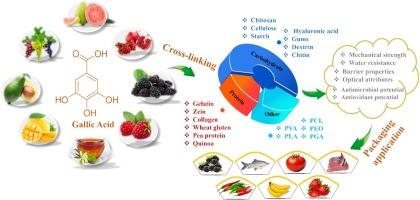Multifunctional performance of gallic acid in biodegradable food packaging films and coatings: Mechanisms, developments, applications, and horizons
IF 5.8
2区 化学
Q1 POLYMER SCIENCE
引用次数: 0
Abstract
There is an increasing interest in the development of degradable and biopolymeric food packaging films (FPFs) based on green ingredients and strategies. To enhance the performance of these films, modifications can be made to the biopolymer molecules, or additives can be incorporated, such as nanomaterials, crosslinkers, bioactive compounds, and other polymers. The use of green compounds is an effective method to improve the performance of degradable FPFs, with gallic acid (GA) being a widely used natural green compound in various biopolymeric films. This review provides an in-depth analysis of GA chemistry and discusses the different types of biopolymeric FPFs crosslinked by GA. Furthermore, it summarizes the recent applications of GA crosslinked biopolymeric FPFs/coatings for food preservation. The comprehensive improvement of biopolymeric films due to GA crosslinking is evident, with the effect on the films’ properties dependent on the concentration of GA and reaction state. The cross-linking of GA with polymer molecules increases the cohesion of the polymer network, with physical and chemical covalent crosslinking being the two main types of cross-linking. Notably, biopolymeric FPFs/coatings crosslinked by GA have demonstrated remarkable effectiveness in preserving fresh foods.

没食子酸在可生物降解食品包装薄膜和涂料中的多功能表现:机理、发展、应用和前景
人们对基于绿色成分和策略开发可降解和生物聚合物食品包装薄膜(FPF)的兴趣与日俱增。为提高这些薄膜的性能,可对生物聚合物分子进行改性,或加入添加剂,如纳米材料、交联剂、生物活性化合物和其他聚合物。使用绿色化合物是提高可降解 FPF 性能的有效方法,其中没食子酸(GA)是一种广泛应用于各种生物聚合物薄膜的天然绿色化合物。本综述深入分析了没食子酸的化学性质,并讨论了由没食子酸交联的不同类型的生物聚合物 FPF。此外,它还总结了 GA 交联生物聚合物 FPFs/ 涂层在食品保鲜方面的最新应用。GA 交联对生物聚合物薄膜的全面改善是显而易见的,对薄膜性能的影响取决于 GA 的浓度和反应状态。GA 与聚合物分子的交联增加了聚合物网络的内聚力,物理交联和化学共价交联是两种主要的交联方式。值得注意的是,由 GA 交联的生物聚合物 FPF/涂层在保鲜食品方面表现出了显著的功效。
本文章由计算机程序翻译,如有差异,请以英文原文为准。
求助全文
约1分钟内获得全文
求助全文
来源期刊

European Polymer Journal
化学-高分子科学
CiteScore
9.90
自引率
10.00%
发文量
691
审稿时长
23 days
期刊介绍:
European Polymer Journal is dedicated to publishing work on fundamental and applied polymer chemistry and macromolecular materials. The journal covers all aspects of polymer synthesis, including polymerization mechanisms and chemical functional transformations, with a focus on novel polymers and the relationships between molecular structure and polymer properties. In addition, we welcome submissions on bio-based or renewable polymers, stimuli-responsive systems and polymer bio-hybrids. European Polymer Journal also publishes research on the biomedical application of polymers, including drug delivery and regenerative medicine. The main scope is covered but not limited to the following core research areas:
Polymer synthesis and functionalization
• Novel synthetic routes for polymerization, functional modification, controlled/living polymerization and precision polymers.
Stimuli-responsive polymers
• Including shape memory and self-healing polymers.
Supramolecular polymers and self-assembly
• Molecular recognition and higher order polymer structures.
Renewable and sustainable polymers
• Bio-based, biodegradable and anti-microbial polymers and polymeric bio-nanocomposites.
Polymers at interfaces and surfaces
• Chemistry and engineering of surfaces with biological relevance, including patterning, antifouling polymers and polymers for membrane applications.
Biomedical applications and nanomedicine
• Polymers for regenerative medicine, drug delivery molecular release and gene therapy
The scope of European Polymer Journal no longer includes Polymer Physics.
 求助内容:
求助内容: 应助结果提醒方式:
应助结果提醒方式:


